What Is the Difference Between Target Market and Target Audience (With Real-Life Examples)
Ever wondered what else the big successful brands have that’s giving them all the edge (besides deep pockets)?
If yes, you’re not the only one. We did, too. So, we did a little digging around and found one of their secrets — they know the real difference between their target market and target audience.
And they understand how to apply that knowledge.
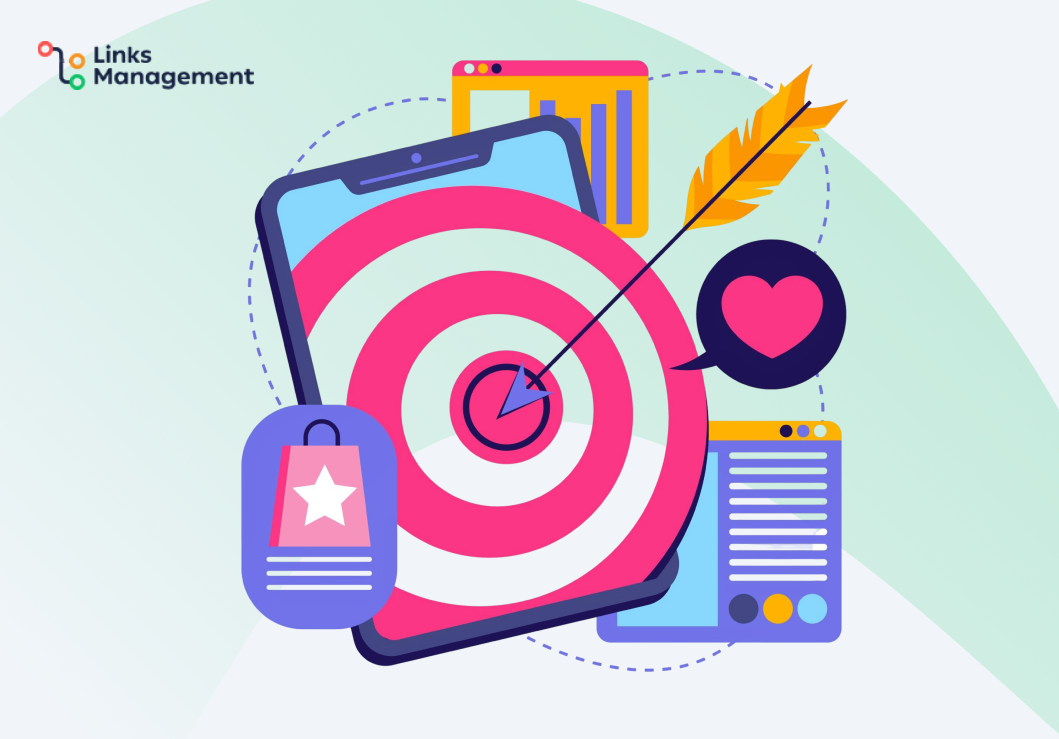
They just don’t waste their time trying to convince the wrong crowd to buy from them. But they don’t mind pouring money into marketing to the same group as long as it’s the right one.
This is a great deal because no amount of campaigns and ads would get a vegetarian to try your new tasty chicken burger. So, marketing success is as much about knowing your market and audience as it is about being creative with your branding and marketing.
But when it comes to the target market vs. target audience question, how does it all work? Glad you asked since the answer is right here, in this guide.
Today, we will look at the two and help untangle the confusion. We will also consider how you can get the most out of your marketing strategy by using both concepts properly.
Contents
- Target Market vs. Target Audience Explained
- How Should You Use Both?
- How to Identify Your Target Market and Target Audience
- #1 Start by Digging Through Your Current Customer Data (Skip If You’re a New Business)
- #2 Market Research Helps (for Both New and Old Businesses)
- #3 Build or Update Your Buyer Personas
- #4 Social Media Helps More Than You Think
- #5 Know Who Isn’t Your Target Audience
- #6 Don’t Take Customer Feedback for Granted
- #7 Invest in the Right Tools
- #8 Regularly Track, Test, and Refine
- Conclusion
Target Market vs. Target Audience Explained
It’s not unusual to find people using both terms interchangeably, but they do not mean the same thing. So, before we explain the difference between the target audience and the target market, let’s make sure we are on the same page about what they mean.
What Is Target Market?

Every product is made with some group of people in mind. The people who your service or product is designed to serve are your target market.
So, if you are selling cute doggie shirts, you are clearly not targeting cat owners or people who only have exotic birds. Nope, only those who have dogs and puppies would fit the profile of your target market.
Typically, you define this group of people based on factors like their age, location, interests, buying habits, etc.
❗Note:
Don’t confuse this term with “market” because there is a difference between a market and a target market.
The market is the broadest term. You know how they always say “electronics market” or “real estate market.” These are extremely generic:
- “Electronics” includes everything from a mixer and a smartphone to a quantum computer.
- At the same time, “real estate” encompasses tons of things, from a tiny studio to a giant manufacturing plant.
If we go back to our dog clothing example, while the target market is dog owners, the market is all pet owners (from a hamster to a cow).
Now, where does the target audience fit into this picture?
What Is Target Audience?
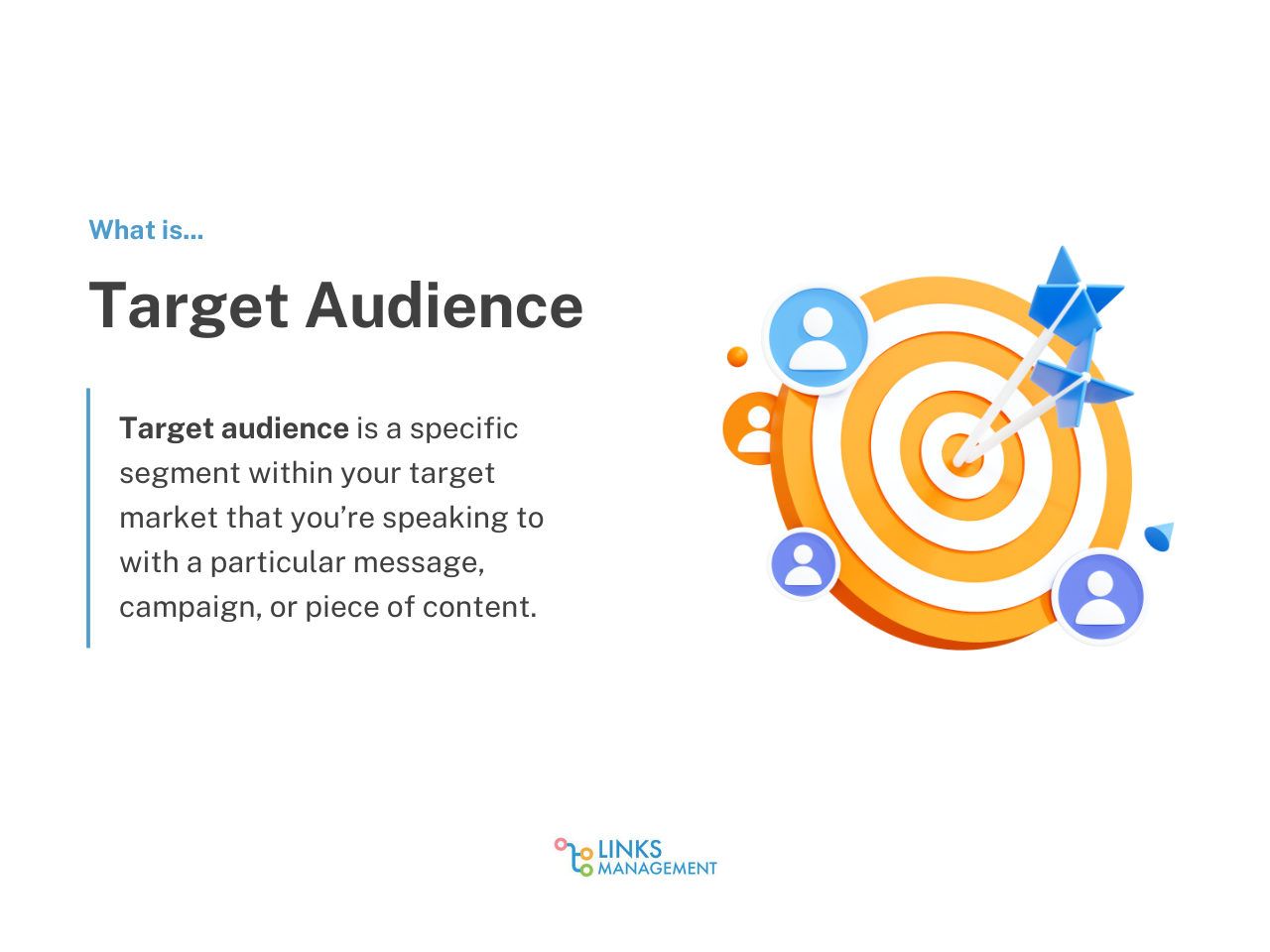
The target audience is basically a smaller group within your target market that you are trying to reach with your product/service and the overall message.
So, say you decide to run a new campaign for only Pitbull owners. Then that would mean your messaging is not aimed at every dog owner out there.
Same thing if you launch an advertising message aimed at dog owners who live in apartments. You can even narrow it down to your Instagram followers who are new customers. You get the idea.
Here, instead of focusing on generic demographics, you want to pay special attention to interests, values, behaviors, etc.
This then means creating articles, guest blog posts, and ads that are aligned to each segment of your target audience.
What Are the Key Differences?
Being able to know and explain the difference between a target market and a target audience can make a big difference. Especially when it comes to your positioning and marketing.
Why? Simply because it gives you an opportunity to personalize your message just right for each type of audience.
- If you’re focusing on the market, that would mean that you’re looking at everyone who could ever need your product or service. This includes even people that you aren’t really targeting right now.
- The target market will mean everyone to whom you want to sell. If you know what a buyer persona is, this is basically a compilation of all your buyer personas — all the people you create your product/service for.
- And the target audience is the exact groups (buyer personas) within your target market. These are those target buyers you personalize your marketing campaigns for.
Let’s look at how this works in real life. Say you’re in the watch business. Then this is what your market, target market, and target audience could look like:
- The market will be everyone who has ever used or is planning to use any type of watch. But we know by now that’s not really practical. You’ll need to narrow it down at least a bit based on the type of watch you offer. This is where your target market comes in.
- The target market could be people interested in luxury watches or smartwatches, for example. These are two absolutely different target markets.
- And the target audience will be the most narrow group. So, if you’re selling smartwatches, you could focus on young runners, like in the campaign below:

Source: Android Community
And if you offer luxury watches, you could target affluent parents, like what Patek Philippe did in one of their legendary campaigns. They said that you don’t really own a watch, you “look after it for the next generation.”

Source: Hodinkee
See why understanding the difference between the target audience and the target market is so important?
If you want to sell your luxury watches to a young, child-free audience, this campaign is a complete failure. And if you’ve tried using the same messaging for the smartwatch crowd, it’d be a total “wait, what?”
Now, let’s summarize the key differences between the two:

- Size: Your target market is generally always larger than the target audience.
- Broad vs. focused. When dealing with the target market, you’re probably looking at many factors. This includes different age groups, income levels, and types of buying behaviors.
- Decision-making process. Generally, your business and marketing decisions will most likely be influenced by your target market. Whereas when it comes to your marketing campaigns, focusing on your target audience is a good idea.
- Factors to consider. When looking at the aspects you have to consider for the target market and target audience, there is a big difference. With the target market, you focus on things like demographics, purchase intent, income, and so on.
- The time factor: There’s a certain level of stability within the target market. Any change that happens has to be driven by something really significant. Your target audience can shift based on the campaign you’re running at the moment, trends, or even the type of content you are creating.
- Discovery tool: To determine who your target market is, you have to perform detailed market research. You know, gathering that intel on demographics and the market itself.
On the other hand, your target audience is often more niche. These could be people within a specific location or with particular interests and needs, etc.
But for the target audience, ideally, you also have to consider several additional factors. Examples are psychographic characteristics, family status, education, occupation, purchasing habits, and many more “sneaky details.”
For example, many beauty companies (including new ones) are now offering products targeted at environmentally and health-conscious users. So, while the target market for beauty products hasn’t changed much for a long time, the target audience has.
For your target audience, you need real-time management metrics. So, things like social media interactions, website traffic, and feedback from customers will work better here. This makes SEO and social listening tools crucial (more details about this later).
A real-life example of how this works is Duolingo. Their target market covers everyone who wants to learn a new language or brush up on their current language skills.

Source: Duolingo
Their target audience, though, will be split into narrow groups based on what language the person wants to learn at the moment and their level. So, they could launch a new ad for those interested in learning French from scratch.
If they narrow this down to the younger audience, then it would mean taking their campaign to TikTok or Instagram. Basically, any platform where the young crowd is likely to hang out would work.
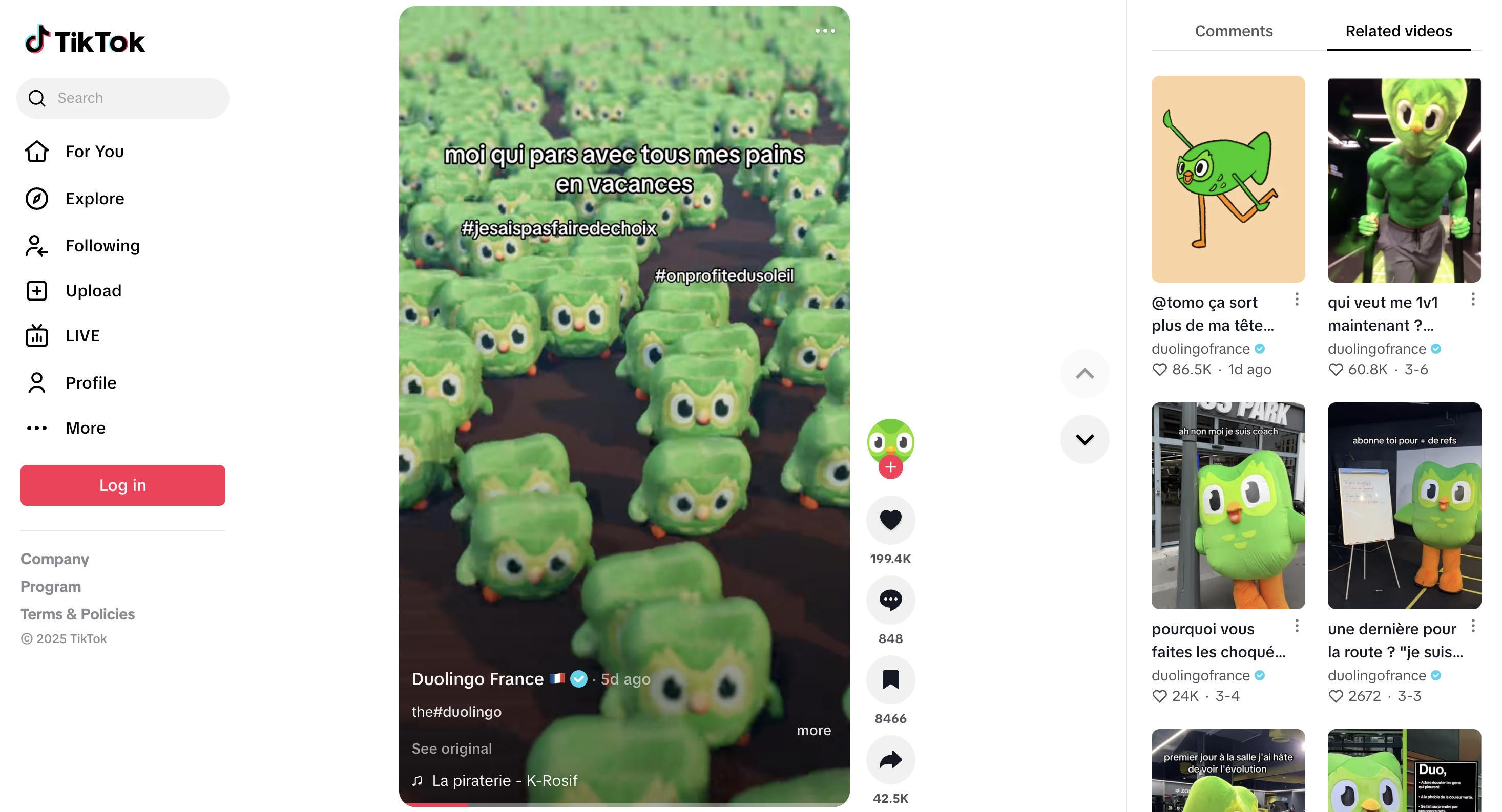
Source: TikTok
How Should You Use Both?
Now that we are on the same page about the difference between target market and target audience, what’s next? Well, it’s time to look at how you can apply this to your marketing and sales strategy.
Overall, you need to know your target market to create a product/service that is in demand. At the same time, understanding your target audiences will help you create those marketing messages that speak directly to the person.
If your marketing and sales teams rely only on your target market, you risk being too generic, which often leads to lower conversions. You know, when you’re trying to sell to everyone, you end up selling to no one.
Now, let’s look at different real-life scenarios:
The Book Publisher
For book publishers, their target market is people who love to read. But then the genre of the book and even the age group, etc., would determine the target audience.
So, say you are publishing a book for young adults. Then, not only does it have to include themes appealing to the younger demographic, but the design and language have to be engaging, too. The book will have to resonate with the young readers.
Naturally, you’ll have to use platforms like TikTok, Instagram, or X and make your content more visual-based. Maybe you could even consider a collaboration with other brands and celebrities.
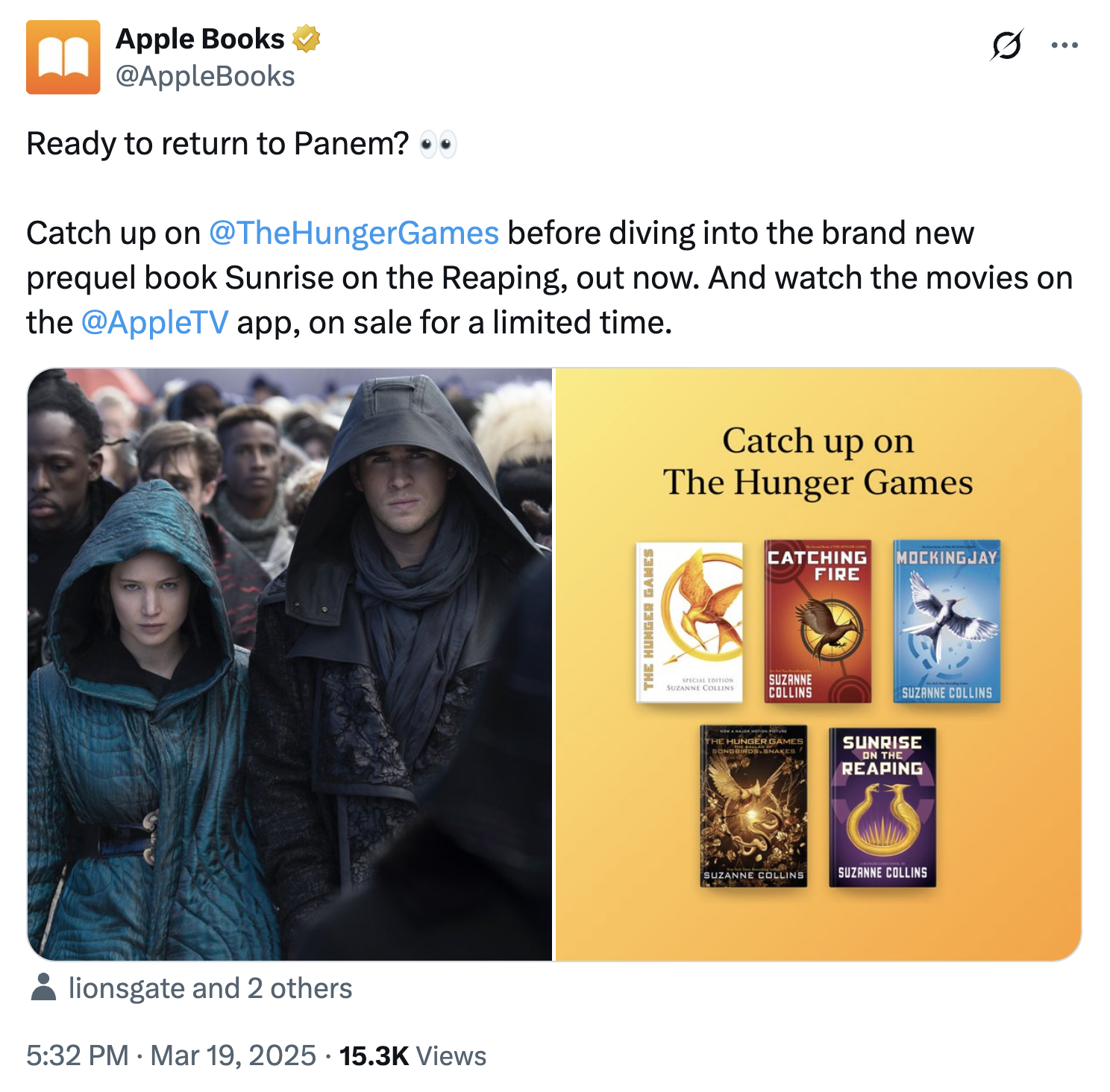
Source: X
The SaaS B2B Company
Once you understand how the target market and target audience work, half the battle is won. You now have the tools to know which features will resonate with each group of your customers.
If you are targeting a white-label SEO company, for example, you will know to include automation features (since agencies handle lots of orders). Plus, you’ll also know:
- What’s a perfect price point for your services;
- Which sales channels you should target (LinkedIn, X, etc.);
- How to tailor your content marketing message. So, if you’re targeting other businesses (as a B2B), you would need ad copies, webinars, and guides. But if you were targeting individual SEO professionals (as a B2C), you might use short reels, YouTube, etc.
The Real Estate Agent
Let’s say you own a really big real estate business. Your target market is most likely anyone looking for property within your location. But you’re probably going to have different types of offerings to appeal to different audiences.
So, for the luxury properties, your ads or content would highlight features like exclusivity, privacy, and other premium benefits.

Source: James Edition
You will prioritize channels like LinkedIn, YouTube, exclusive real estate listings, SEO, PPC, and so on. You might even add special features to your website, like virtual tours.
Naturally, this won’t be the case when targeting first-time homeowners. In this scenario, you might need to make educational videos explaining what a first-time home buyer needs to watch out for. Your messaging will also focus on affordability, great value for money, etc.
This will help build trust and shift your brand-customer relationship from awareness to loyalty.
How to Identify Your Target Market and Target Audience
At this stage, you’re way past the question, “What is the difference between target market and target audience?” Now, our focus is on how you could spot them and, of course, how to leverage both. So, here are our best tips for any business:
#1 Start by Digging Through Your Current Customer Data (Skip If You’re a New Business)
Okay, this one is mostly for those who already have a business that’s been running for a while.
Likely, you know your target market by now. Most of the confusion usually comes from trying to define your target audiences. Still, either way, your customer base can help you with both.
Start by going through all your clients’ data and see if you notice any patterns. In addition to this, you could run surveys and polls using emails, your website, or social media.
This can give you a chance to connect with your audience and get to know them better. Plus, their feedback could help you improve your strategy.
What’s next? This will depend on what you want to determine:
- If you want to specify what your target market is, find a general group of people who your product/service aims at. It would be very useful to write their basic characteristics, like age, interests, income level, location, etc. Still, remember that this one is broad.
- If you’re trying to figure out who your target audience is, you will need to spot different “client profiles” in all your customer data. This is where your buyer personas come into play (we’ll cover this in detail in #3).
But what if you are a new business? Then, the next one is for you.
#2 Market Research Helps (for Both New and Old Businesses)
Just like with the previous tactic, you can run surveys or even conduct interviews to know who your target audience is. If you’re still in the initial stages of your business journey, you really need to try to get as much information as possible.
So, don’t limit yourself to just demographics. Sometimes, even the things that seem “unrelated” to your business can give you a good idea about your audience.
If you were your customer, what kind of business would you prefer to buy from and why? What type of content would be helpful to you? What would you do in your free time? What would your life goals be? All these questions can be really helpful to get to know your people.
This will clue you in on who your actual prospective customer might be.
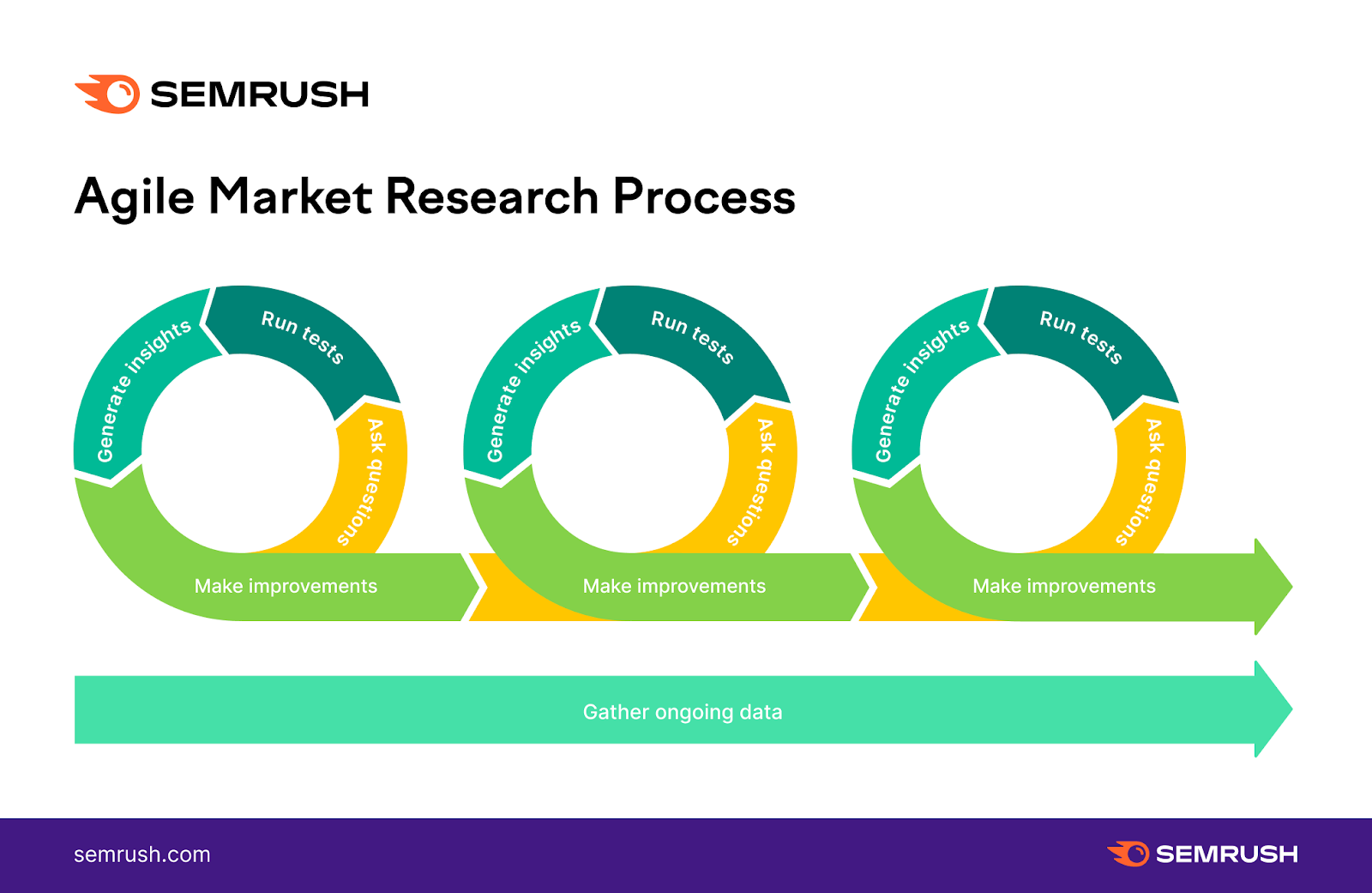
Source: Semrush
Keep in mind that it’s not just about who is buying from you and what drives them to choose you. You also need to focus on what value or solution your content/product/service adds to their lives.
You could also slide into online forums and communities. You know, to see what people are struggling with when accessing services or buying products in your niche. This kind of insight is very valuable.
Naturally, you will want to look at what the competitors in your industry are doing as well and how people respond to them. This is a great way to learn what your target audience likes and hates.
The best part? Tools like Meta Audience Insights, Google Analytics, all types of social-listening tools, and SEO software can help you make it easier to find some useful information.
#3 Build or Update Your Buyer Personas
Your buyer persona is a composite picture of who your ideal customer is. It helps you gain a better understanding of your target audience — their challenges, needs, worries, aspirations, etc.
What does a buyer persona profile look like?
It’s kind of like an “ID card” that has common details about a group of your buyers. So, here, you should specify demographics, pain points, buying triggers, behavior patterns, etc.
As you can understand now, we’re talking about the target audience here, not the target market.

Source: Semrush
If you’ve never created a buyer persona profile before, simply use any free buyer template maker for this part.
It’s even better when you can build this persona based on real data you have gathered from your market research. Ideally, it should only be like that.
A buyer persona is typically described as one particular person. But it represents a whole group of your clients. So, don’t forget about that. When grouping everyone based on your research, make sure that your profiles actually represent big parts of your target audience.
This segmentation could be done based on anything (literally), from geography and stage of the sales funnel to what content these people consume and where they see themselves in 5 years, etc. The whole thing will only depend on your business, marketing, and sales objectives.
#4 Social Media Helps More Than You Think
Social media has always been a powerful marketing tool, and that’s still true even now.
Most people check out brands’ social media accounts before they even decide to buy from them. So, this could be a way to build social proof, especially when you actively participate in trends and share testimonials.
But here’s where it gets interesting — as users interact with your posts, you get valuable real-time insights. You know, the scope of customer’s behaviors, preferences, interests, etc.
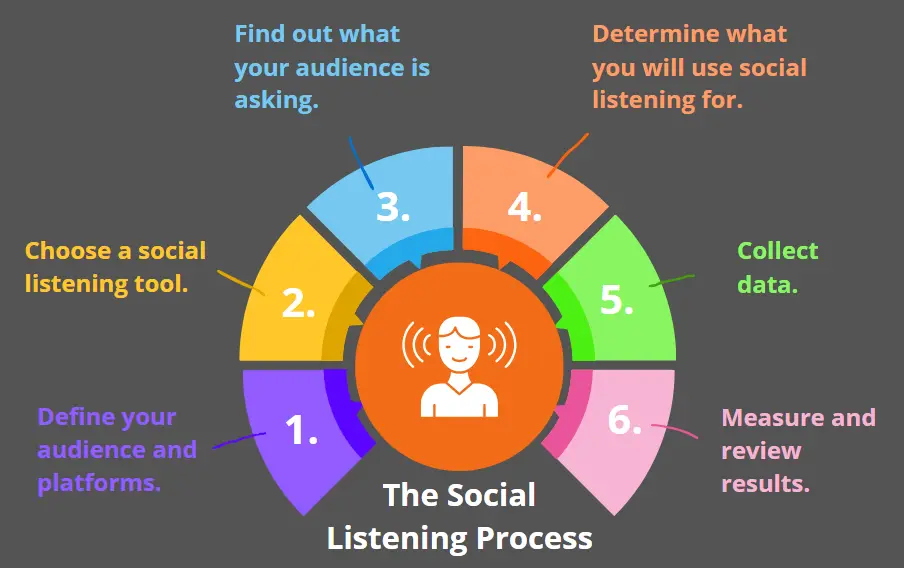
Source: Neil Patel
Using a social media listening tool can let you keep a pulse on how your running campaigns are perceived. Not only do you get insights into how many people or audiences vibe with you, but you will be able to see why.
This can be much needed when you are building your next campaign or content marketing strategy.
And, of course, all this data can help you identify new target audiences. Remember we said that these might be influenced by trends? That’s exactly why monitoring what people care about is crucial. You might discover a need for a particular feature, product, or positioning.
#5 Know Who Isn’t Your Target Audience
Okay, this one might sound funny, but it is just as important. When learning about who your target audience vs. target market is, you also need to know who isn’t on either of those lists.
Why? Because it will save you tons of money, time, and other resources. Really, think about it.
Sometimes, some consumers can look an awful lot like your target audience. Except for one problem — they just never respond to any of your messages. They never buy, click, sign up, or engage with your offers, but they look like they fit the profile. Why?
Well, people are people. They may just have different interests or even a lifestyle where your product/service just doesn’t fit. That’s fine.
But the problem is you could be investing all that time and resources into trying to woo them and getting no results. Especially when you could focus on your actual audience instead and get better ROI for your troubles.
This is where you can conduct your win-loss analysis. The idea is to understand why you get rejections or lost deals. Then, you can try to examine the profiles of people who never became your customers. Do they have anything in common?
If that’s the case, then that segment of your market might not be your actual target audience. Still, you can try to tweak your messaging or some of your strategies to see if you can finally win those clients.
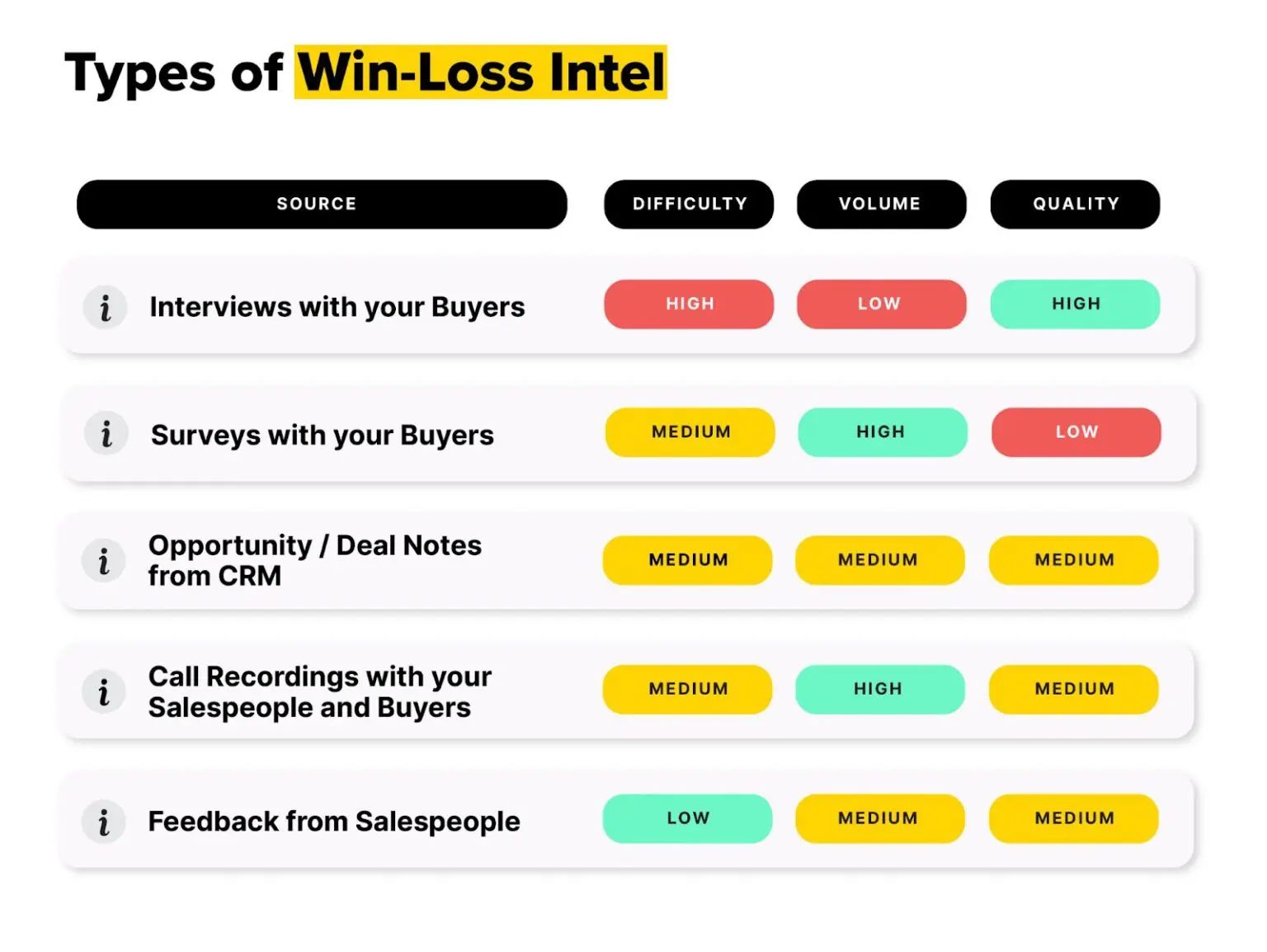
Source: Klue
#6 Don’t Take Customer Feedback for Granted
Yes, we have mentioned this several times before, but it’s worth repeating because it is so important. There’s nothing like hearing directly from your target audience what you are doing right and where you could do better.
So, you want to have a system in place for gathering data from your feedback. This could be as simple as sending surveys after your sales process is completed, maybe via email. You could also have a way for customers to share their reviews (especially the bad ones) anonymously.
Plus, give your buyers as many opportunities as possible to share their experiences with you. This could be through your social media pages, Google Business Profile, and even your website.
This will help you redefine your offerings and come up with marketing strategies that people can resonate with.
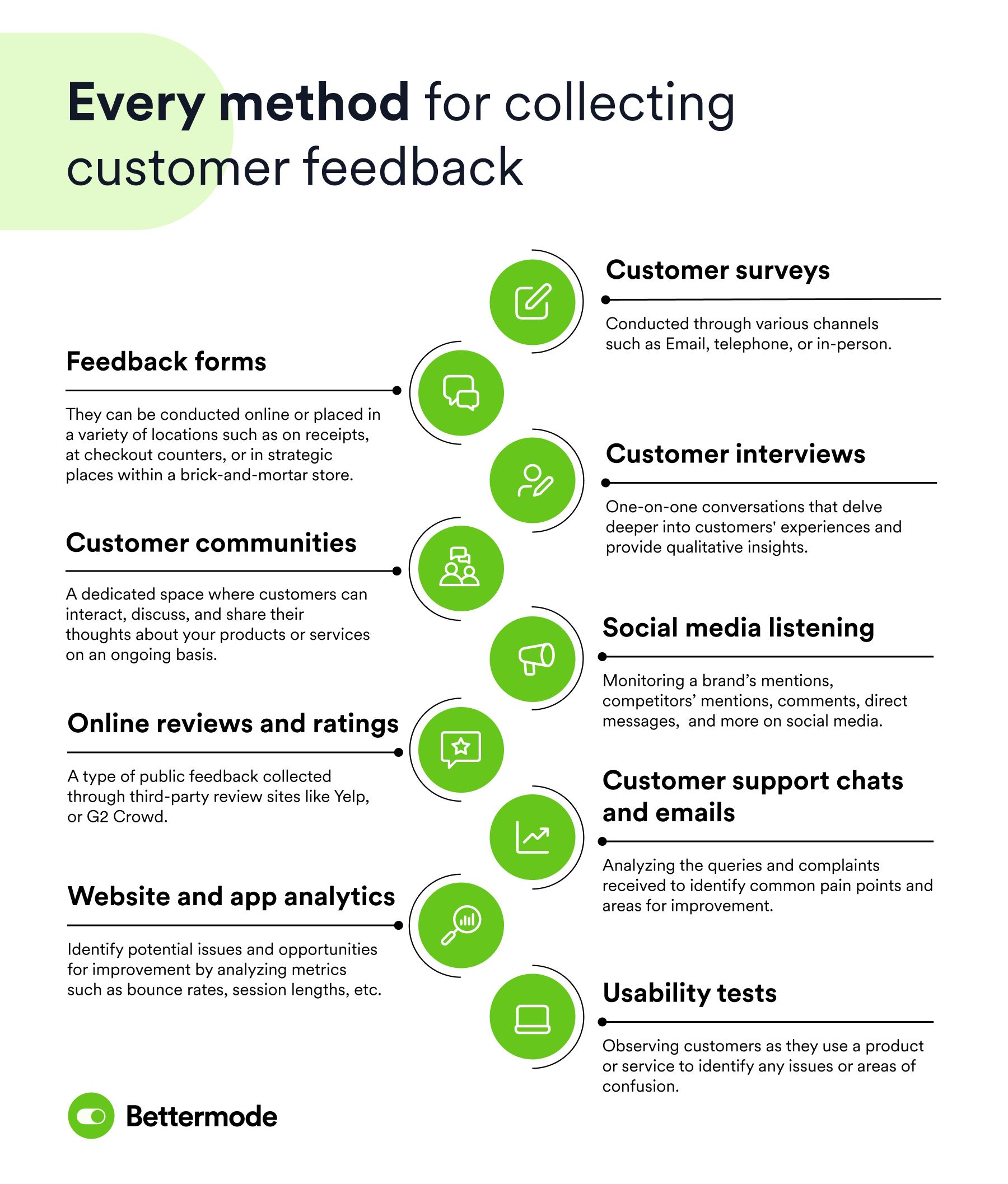
Source: Bettermode
#7 Invest in the Right Tools
All of this data or insights gathering means one thing — you will need to invest in the right tools. First off, what software can help you identify your target market and target audience? That’s a great question.
We have already mentioned social listening tools, Meta Audience Insights, and a couple of other solutions. But that’s not all there is. Some of the options you might want to try include:
- Google Analytics. This one works for both analyzing audience insights and their behaviors as well. You can use it to check who visits your site and how they interact there. You will learn about their demographics, interests, locations, etc.
- Google Trends. It’s perfect for researching your target audience. You can quickly spot which topics your target audience is interested in at any time. Best part? It also works great for those who are targeting customers across different countries.

Source: Google Trends
- Semrush and Ahrefs. These are great not just for keyword research but also for checking what your competitors are doing. With these tools, you can discover the gaps they are not filling in their content strategy. As a result, you can gain extra advantages by knowing what you could do better.
- Statista/Pew Research. These are two great tools for target market research. They allow you to gather macro-level market data by region, behavior, industry, etc. While these options are great for researching your market, you might also use them to understand some tendencies that will influence your target audience.
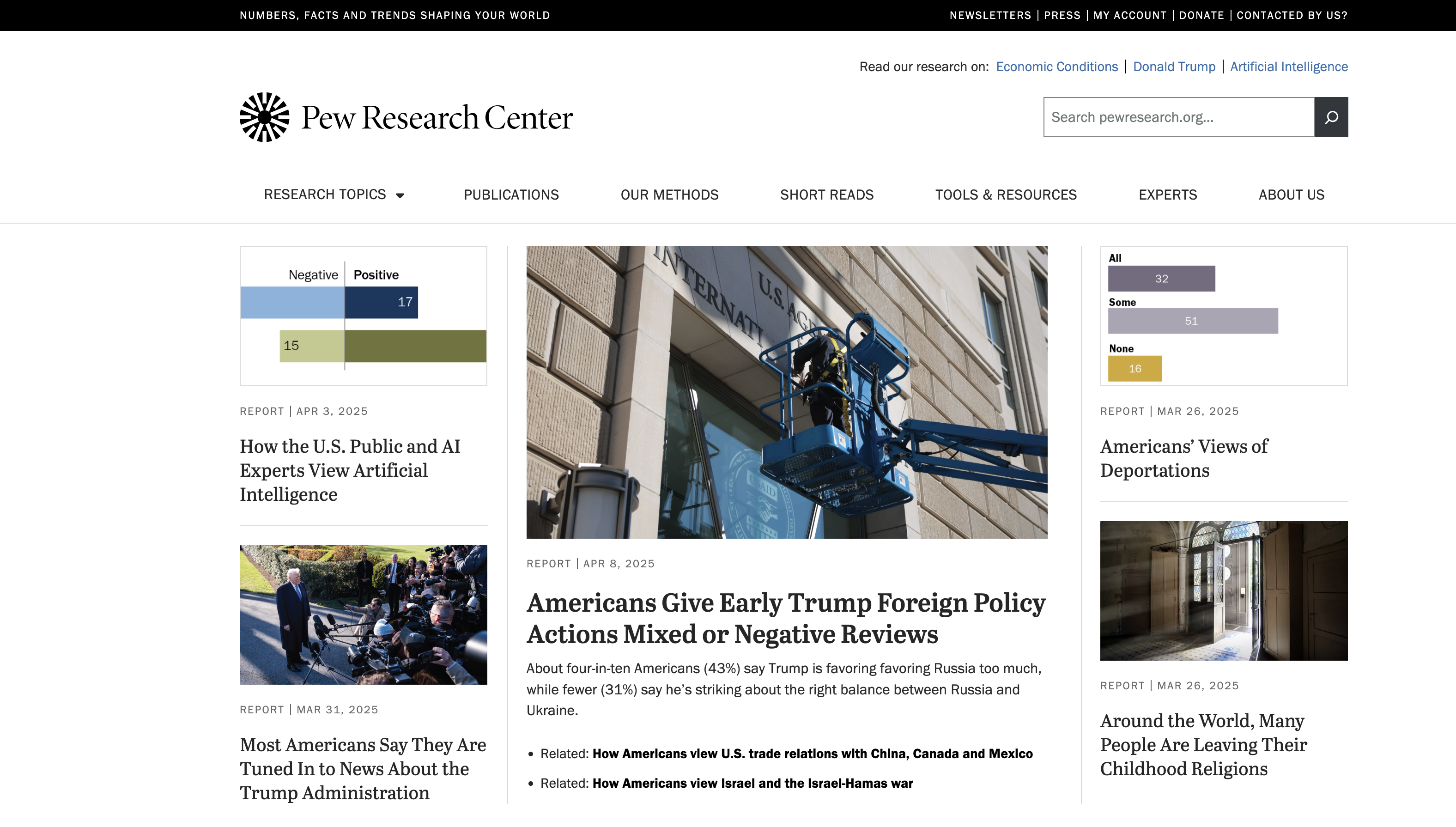
Source: Pew Research Center
- YouGov. You can use this for audience profiling based on actual consumer data. This makes it useful for both target audience and target market research.
- Surveys/poll tools. Think of platforms like Typeform and SurveyMonkey. They are designed to make it easy for you to create engaging surveys for your market and audience research.
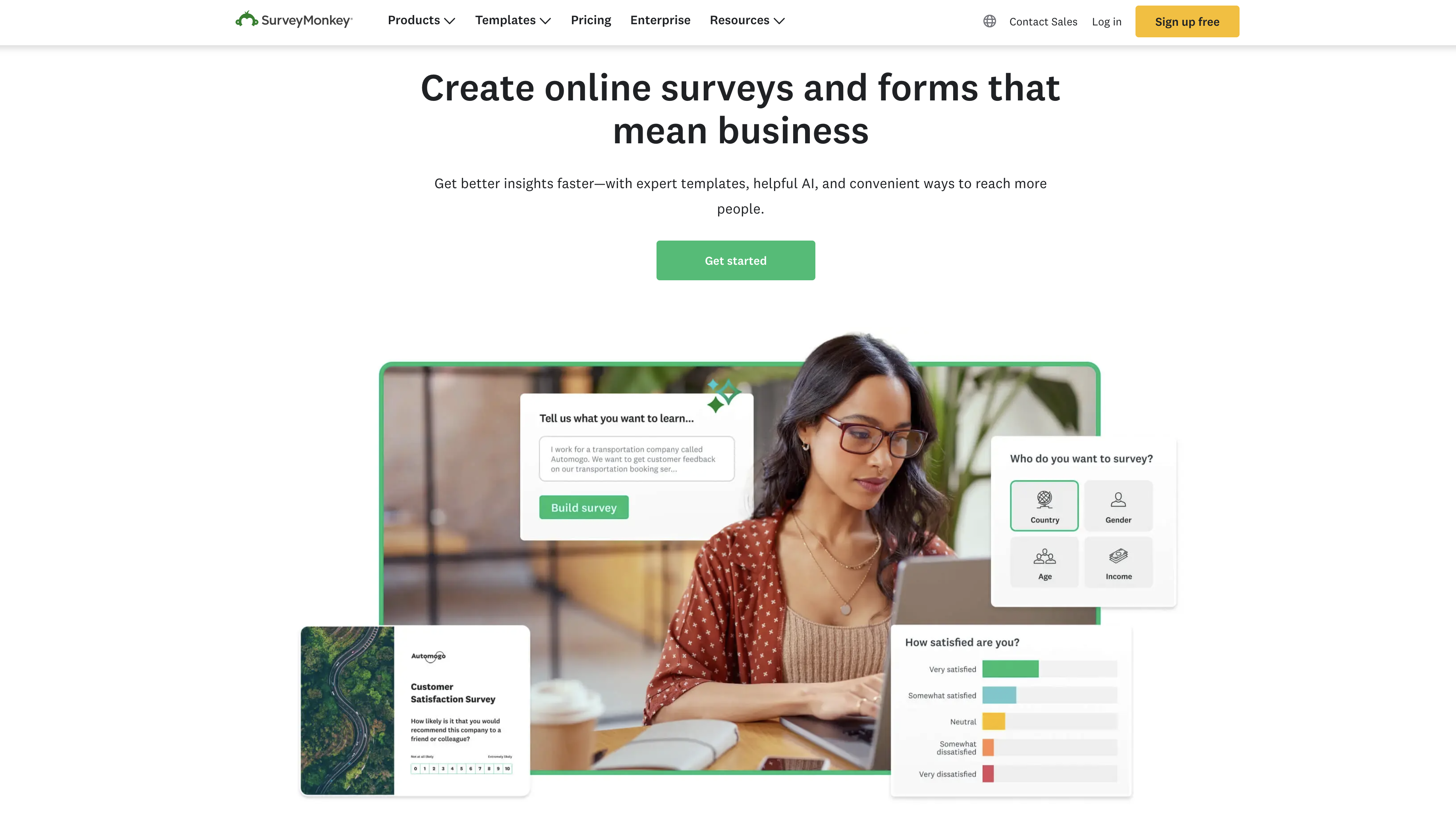
Source: SurveyMonkey
- CRM tools. You will also need to analyze leads and customer behavior, especially when you are building buyer personas. That’s where CRM tools come in. They can be extremely helpful in understanding how your clients move through the customer journey.
Of course, these are not the only options available. But they’re a great place to start. Even if you can only invest in one or two of these, it would still make a big difference.
#8 Regularly Track, Test, and Refine
You already know that everyone is not your target audience. But here’s the thing — you can’t just relax once you find your actual customers. Why? Because the market is always changing and always flowing. Kind of like people.
So, to be safe, you will need to keep track of what’s buzzing amongst your audience. You should be able to shift gears and adapt to their new interests and challenges as fast as possible.
For example, say your customer service was only available during work hours. Now, you can offer 24/7 round-the-clock access to customer support thanks to AI-powered chatbots (if that’s what your clients need).
Being sensitive to all these changes ensures that you remain relevant.
To keep track of this, you’ll need to use those tools you invested in. Sometimes, even when a message is right, you’ll still have to tweak it from time to time so it doesn’t become too repetitive. When it comes to messaging, A/B testing should become your best friend.
All this might sound unnecessary. But in reality, this is the only way to maintain a competitive edge.
Conclusion
So, we have covered all the differences between target market vs. target customers. At this point, you are quite the expert yourself and can help someone gain clarity about why it matters.
As a marketer or SEO professional, your strategizing skills will be more sharpened now. This translates into higher efficiency and productivity. As a result, you will be able to record higher revenue. But to get there, you’ll have to be consistent.
Enter URL & See What We Can Do Submit the form to get a detailed report, based on the comprehensive seo analysis.





